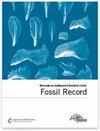下载PDF
{"title":"晚二叠纪-侏罗纪放射虫灭绝率的轨迹:没有证据表明三叠纪末发生了大规模灭绝","authors":"Wolfgang Kiessling, Taniel Danelian","doi":"10.1002/mmng.201000017","DOIUrl":null,"url":null,"abstract":"<p>The hypothesis that ocean acidification was a proximate trigger of the marine end-Triassic mass extinction rests on the assumption that taxa that strongly invest in the secretion of calcium-carbonate skeletons were significantly more affected by the crisis than other taxa. An argument against this hypothesis is the great extinction toll of radiolarians that has been reported from work on local sections. Radiolarians have siliceous tests and thus should be less affected by ocean acidification. We compiled taxonomically vetted occurrences of late Permian and Mesozoic radiolarians and analyzed extinction dynamics of radiolarian genera. Although extinction rates were high at the end of the Triassic, there is no evidence for a mass extinction in radiolarians but rather significantly higher background extinction in the Triassic than in the Jurassic. Although the causes for this decline in background extinction levels remain unclear, the lack of a major evolutionary response to the end-Triassic event, gives support for the hypothesis that ocean acidification was involved in the dramatic extinctions of many calcifying taxa. (© 2011 WILEY-VCH Verlag GmbH & Co. KGaA, Weinheim)</p>","PeriodicalId":55147,"journal":{"name":"Fossil Record","volume":"14 1","pages":"95-101"},"PeriodicalIF":2.1000,"publicationDate":"2011-02-22","publicationTypes":"Journal Article","fieldsOfStudy":null,"isOpenAccess":false,"openAccessPdf":"https://sci-hub-pdf.com/10.1002/mmng.201000017","citationCount":"18","resultStr":"{\"title\":\"Trajectories of Late Permian – Jurassic radiolarian extinction rates: no evidence for an end-Triassic mass extinction\",\"authors\":\"Wolfgang Kiessling, Taniel Danelian\",\"doi\":\"10.1002/mmng.201000017\",\"DOIUrl\":null,\"url\":null,\"abstract\":\"<p>The hypothesis that ocean acidification was a proximate trigger of the marine end-Triassic mass extinction rests on the assumption that taxa that strongly invest in the secretion of calcium-carbonate skeletons were significantly more affected by the crisis than other taxa. An argument against this hypothesis is the great extinction toll of radiolarians that has been reported from work on local sections. Radiolarians have siliceous tests and thus should be less affected by ocean acidification. We compiled taxonomically vetted occurrences of late Permian and Mesozoic radiolarians and analyzed extinction dynamics of radiolarian genera. Although extinction rates were high at the end of the Triassic, there is no evidence for a mass extinction in radiolarians but rather significantly higher background extinction in the Triassic than in the Jurassic. Although the causes for this decline in background extinction levels remain unclear, the lack of a major evolutionary response to the end-Triassic event, gives support for the hypothesis that ocean acidification was involved in the dramatic extinctions of many calcifying taxa. (© 2011 WILEY-VCH Verlag GmbH & Co. KGaA, Weinheim)</p>\",\"PeriodicalId\":55147,\"journal\":{\"name\":\"Fossil Record\",\"volume\":\"14 1\",\"pages\":\"95-101\"},\"PeriodicalIF\":2.1000,\"publicationDate\":\"2011-02-22\",\"publicationTypes\":\"Journal Article\",\"fieldsOfStudy\":null,\"isOpenAccess\":false,\"openAccessPdf\":\"https://sci-hub-pdf.com/10.1002/mmng.201000017\",\"citationCount\":\"18\",\"resultStr\":null,\"platform\":\"Semanticscholar\",\"paperid\":null,\"PeriodicalName\":\"Fossil Record\",\"FirstCategoryId\":\"89\",\"ListUrlMain\":\"https://onlinelibrary.wiley.com/doi/10.1002/mmng.201000017\",\"RegionNum\":4,\"RegionCategory\":\"地球科学\",\"ArticlePicture\":[],\"TitleCN\":null,\"AbstractTextCN\":null,\"PMCID\":null,\"EPubDate\":\"\",\"PubModel\":\"\",\"JCR\":\"Q3\",\"JCRName\":\"Earth and Planetary Sciences\",\"Score\":null,\"Total\":0}","platform":"Semanticscholar","paperid":null,"PeriodicalName":"Fossil Record","FirstCategoryId":"89","ListUrlMain":"https://onlinelibrary.wiley.com/doi/10.1002/mmng.201000017","RegionNum":4,"RegionCategory":"地球科学","ArticlePicture":[],"TitleCN":null,"AbstractTextCN":null,"PMCID":null,"EPubDate":"","PubModel":"","JCR":"Q3","JCRName":"Earth and Planetary Sciences","Score":null,"Total":0}
引用次数: 18
引用
批量引用

 求助内容:
求助内容: 应助结果提醒方式:
应助结果提醒方式:


